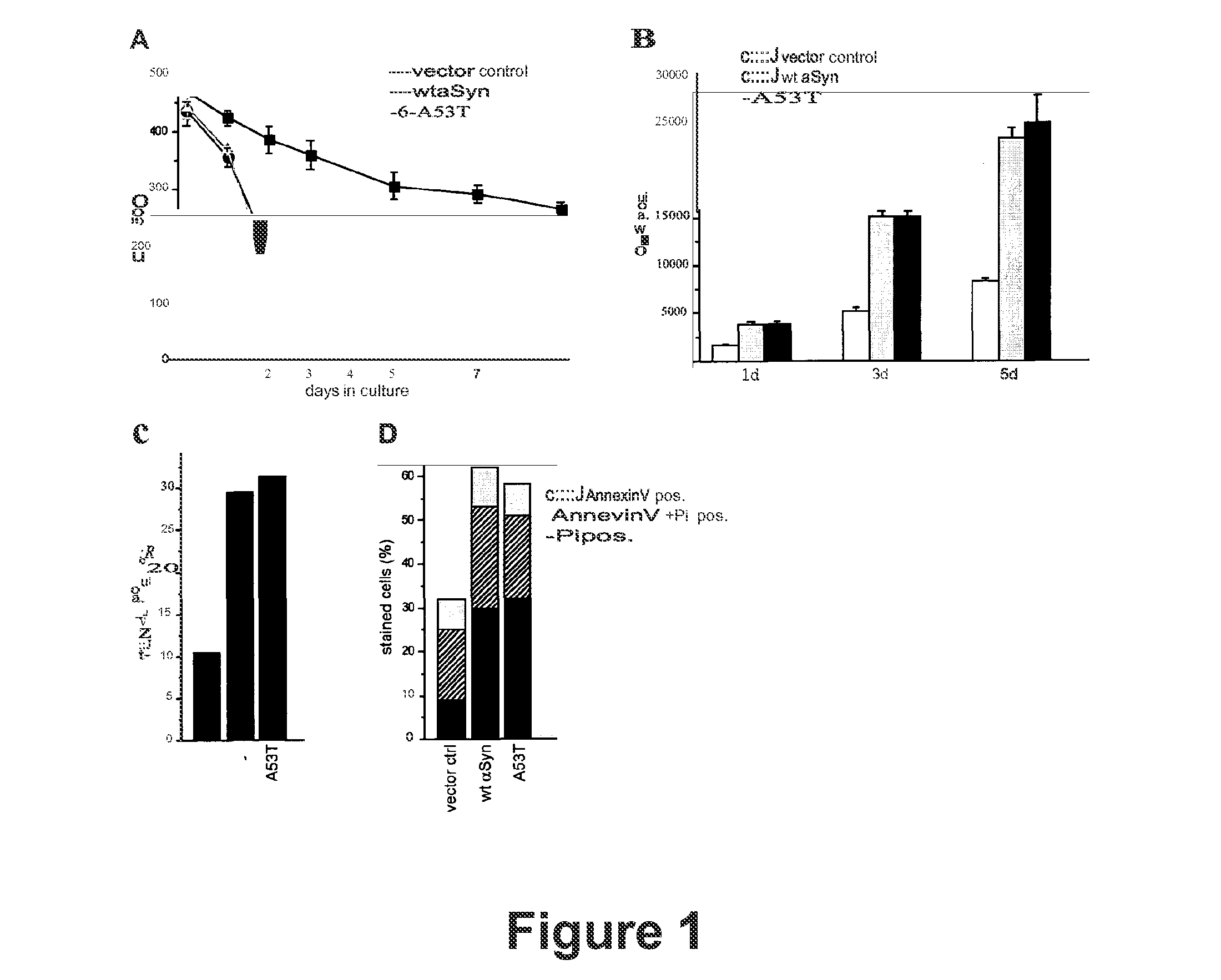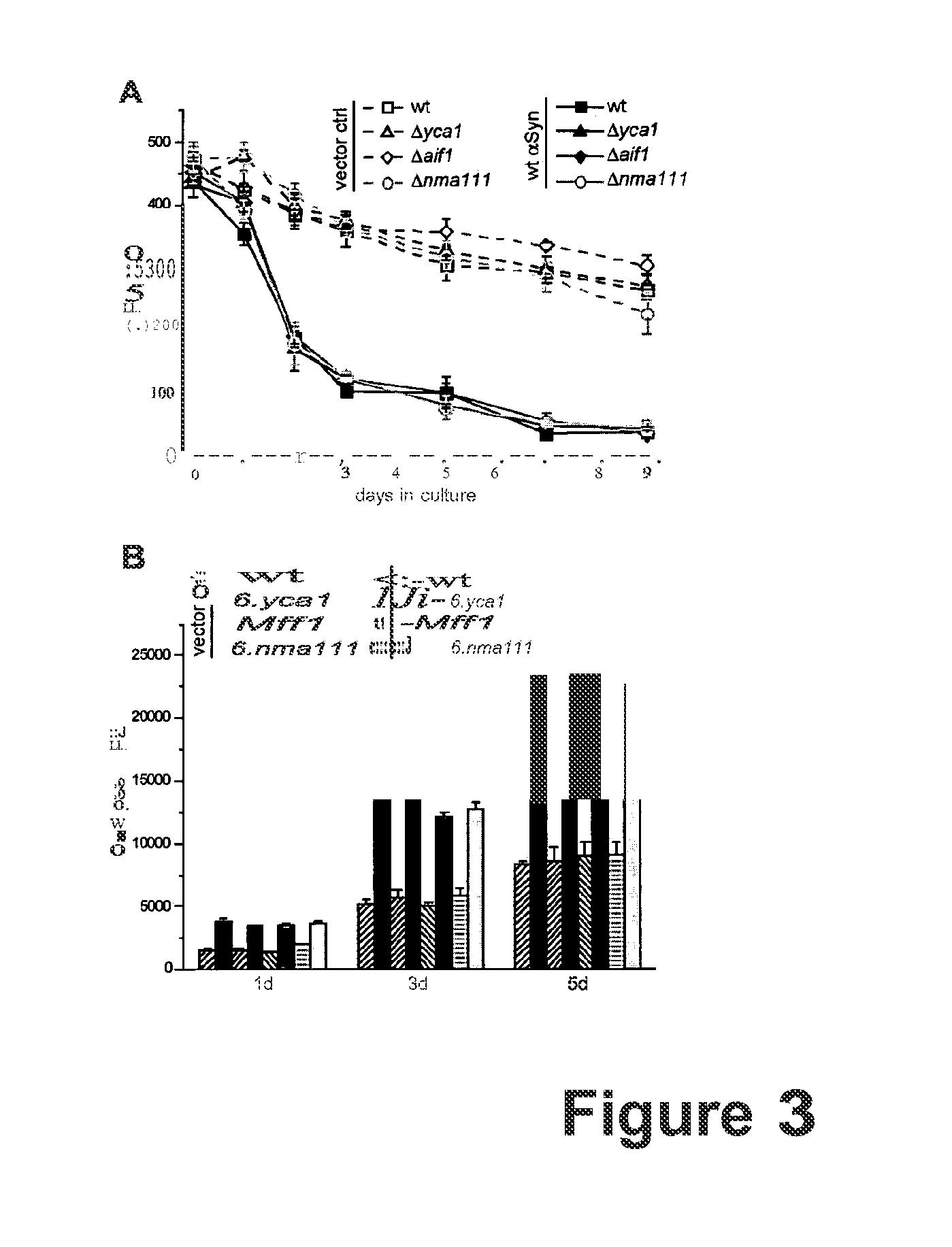Alpha synuclein toxicity
a technology of synuclein and toxicity, applied in the direction of enzyme inhibitor ingredients, peptide/protein ingredients, antibody medical ingredients, etc., can solve the problems of elusive downstream events or cell death executors required for -synuclein mediated death
- Summary
- Abstract
- Description
- Claims
- Application Information
AI Technical Summary
Benefits of technology
Problems solved by technology
Method used
Image
Examples
example 1
Materials and Methods
Yeast Strains And Molecular Biology
[0070]Experiments were carried out in BY4741 (MATa his3Δ1 leu2Δ0 met15Δ0 ura3Δ0) and respective null mutants, obtained from Euroscarf, or in W303-1A (MATa can1-100 ade2-1 his3-11 trp1-1 ura 3-1 leu 2-3, 112). All strains were grown on SC medium containing 0.17% yeast nitrogen base (Difco), 0.5% (NH4)2S04 and 30 mg / l of all amino acids (except 80 mg / l histidine and 200 mg / l leucine), 30 mg / l adenine, and 320 mg / l uracil with 2% glucose (SCD), or 2% galactose (SCG) for induction of expression of α-synuclein-FLAG constructs. For abrogation of the mitochondrial DNA, BY4741a were grown in YEPD media.
Plasmids
[0071]Plasmids for constitutive expression of native α-synuclein under control of the TPI promoter were previously described (Zabrocki et al., 2005). To construct α-synuclein-FLAG and A53T-FLAG, the cDNAs for wild type and A53T α-synuclein were introduced into pESC-His (Stratagene) where expression is controlled by the glucose-re...
example 2
Death in Ageing Cultures Mediated by Heterologous Expression of Human α-Synuclein is Accompanied by Phenotypic Manifestations of Apoptosis and Necrosis.
[0075]Though many neurodegenerative disorders are tightly associated with ageing, the relationship between α-synuclein-mediated toxicity, ageing and cell death has not been fully elucidated. Therefore, we applied yeast chronological ageing, a well-established model for regulation of ageing in post-mitotic mammalian cells and to date the best studied physiological scenario of apoptosis induction in wild type yeast (Fabrizio et al., 2004; Herker et al., 2004) to further characterize age-dependent α-synuclein-mediated toxicity.
[0076]We expressed native wild type α-synuclein (wt-Syn) and a mutated variant (A53T) found in early-onset hereditary transmitted PD under the control of an inducible GAL promoter in BYa wild type yeast cells and determined survival during ageing. As shown in FIG. 1A, expression of wt-Syn led to rapid cell killing...
example 3
α-Synuclein Mediated Death and ROS-Production Depends on Functional Mitochondria but is Independent of the Unfolded Protein Response (UPR).
[0078]ROS-accumulation is a prominent phenotype during ageing and apoptosis of organisms ranging from yeast to mammals. Reportedly, ROS are generated mainly from two sources: the UPR-regulated oxidative folding machinery and the mitochondria. The accumulation of misfolded proteins within the endoplasmic reticulim (ER) leads to prolonged activation unfolded protein responses (UPR), which in turn causes oxidative stress and finally cell death (Haynes et al., 2004). To test whether Synuclein-mediated death depends on the UPR-activated cell death pathway, α-synuclein was expressed in the deletion mutants of two key players of the UPR-activation, Δire1 and Δhac1. Ire1 p initiates the unfolded protein response by regulating the synthesis of the transcription factor Had p (Sidrauski and Walter, 1997; Welihinda and Kaufman, 1996; Welihinda et al., 1999)....
PUM
| Property | Measurement | Unit |
|---|---|---|
| time | aaaaa | aaaaa |
| pH | aaaaa | aaaaa |
| pH | aaaaa | aaaaa |
Abstract
Description
Claims
Application Information
 Login to View More
Login to View More - R&D
- Intellectual Property
- Life Sciences
- Materials
- Tech Scout
- Unparalleled Data Quality
- Higher Quality Content
- 60% Fewer Hallucinations
Browse by: Latest US Patents, China's latest patents, Technical Efficacy Thesaurus, Application Domain, Technology Topic, Popular Technical Reports.
© 2025 PatSnap. All rights reserved.Legal|Privacy policy|Modern Slavery Act Transparency Statement|Sitemap|About US| Contact US: help@patsnap.com



